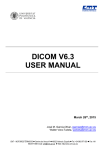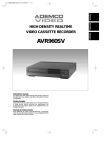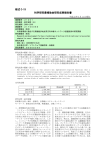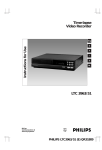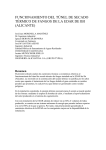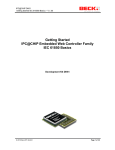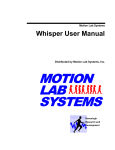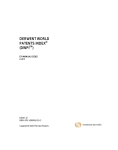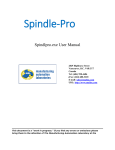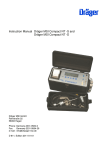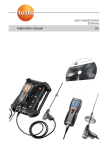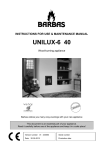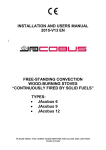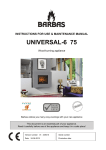Download DICOM V5.3 USER MANUAL - CMT
Transcript
DICOM V5.3 USER MANUAL September 5th, 2013 CMT – MOTORES TÉRMICOS Camino de Vera s/nº 46022 Valencia. España Tel. +34 963 877 650 Fax +34 963 877 659 E-mail: [email protected] Web: http://www.cmt.upv.es CONTENTS 1 INTRODUCTION ......................................................................................................................................... 3 2 INPUT DATA .................................................................................................¡Error! Marcador no definido. 2.1 STEADY CALCULATION ..................................................... 4 2.1.1 GENERAL .................................................................................................................................... 4 2.1.2 NUMERICS ................................................................................................................................. 5 2.1.3 MORPHOLOGY ........................................................................................................................... 6 2.1.4 INJECTION RATE ......................................................................................................................... 6 2.1.5 MIXING LAW .............................................................................................................................. 8 2.2 TRANSIENT CALCULATION ............................................. 10 3 2.2.1 GENERAL .................................................................................................................................. 10 2.2.2 NUMERICS ............................................................................................................................... 11 2.2.3 DISCRETIZATION ...................................................................................................................... 12 2.2.4 MORPHOLOGY ......................................................................................................................... 13 2.2.5 INJECTION RATE ....................................................................................................................... 14 2.2.6 MIXING LAW ............................................................................................................................ 15 OUTPUT FILES .......................................................................................................................................... 18 3.1 Relst.dat.............................................................................. 18 3.2 Integ.dat .............................................................................. 18 3.3 temp1.dat ............................................................................ 19 3.4 temp2.dat ............................................................................ 19 3.5 xdata.dat ............................................................................. 21 4 REFERENCES............................................................................................................................................. 23 DICOM V5.3 USER MANUAL – Sept 5th 2013 2 1 INTRODUCTION DICOM is a one-dimensional (1D) spray model that predicts the evolution of a turbulent jet under some simplifying hypotheses. Scientific basis for the model can be found in [1-3]. This document summarizes the main steps for a user to perform a calculation. The general flow of information is described in Figure 1. The user interface is the only graphic interface of the program. It allows the introduction of both the model needed input data, and also the location of the output data. This user interface makes it possible to edit/manage/save an input file, which stores the configuration for one case, and launches the solver, which performs the calculations. After the calculation, output information is written into ASCII text files. This type of file allows the utilization of different software for further processing and plotting the data. USER INTERFACE CASE FILE: Input.txt DICOM SOLVER OUTPUT FILES Figure 1. General flow of information in DICOM In Section 2, a brief description is given of the general User Interface. In Section 3, the parameters needed to create a calculation case will be explained, as well as how to feed them into the program. Finally, Section 4 contains the description of output files. 2 USER INTERFACE The user interface allows the introduction of input data, the management of input files and the execution of the solver. A series of tabs have been arranged in the program main window to provide the program with the necessary info to set up a case. On the other hand, there are three buttons on the right-hand side of the user interface to manage input data files (Figure 2): Open: loads input data of a previous test from a text file. Save: saves the current case configuration case in a text file. Start: starts the calculation. Figure 2. User input interface, 'GENERAL' tab for Steady case. DICOM V5.3 USER MANUAL – Sept 5th 2013 3 The general working flow is as follows The user fills the input information directly or by uploading a case file. After clicking upon ‘Start’ The following events occur: o The user is asked to save the input configuration in a file. This is a security just in case this information has not been saved yet. o For reacting cases, a value of the cone angle for the reacting part of the spray (i.e. downstream of lift-off) is asked for. This value is not saved in the input file. o Finally, the solver is launched, and calculation proceeds until it is finished. The code output information can be analyzed. 3 INPUT DATA Different tabs are available in the user interface that allow for the configuration of one case. The main one is the GENERAL tab, where one can choose between the two main approaches for DICOM calculation: STEADY: In this case, boundary conditions for spray development are constant with time. This means time-constant nozzle injection parameters (injection mass and momentum fluxes) and time-constant injection and ambient thermodynamic variables and composition. All input parameters are therefore scalar values. TRANSIENT: In this case, all or some of the above-mentioned boundary conditions may change with time. Accordingly, input data is made up of text files containing the time evolution of these variables. Even though there are few differences between both approaches, namely if some of the variables are time-constant or change with time, the present section will describe the input form in two subsections, the first one for the steady case, the second one for the transient case. One important issue is that fuel properties are compiled into the corresponding executable file. Accordingly, different versions of the code have to be used to change fuel type. 3.1 STEADY CALCULATION As previously described, steady calculations apply for sprays where injection conditions and chamber properties are constant with time. Therefore, there will not be need for input data in text file format for injection, density or pressure in function of the time. All necessary input information will be fed directly from the input user interface. The execution of the code will be much faster than the transient case, where time evolution has to be tracked. 3.1.1 GENERAL The first tab allows selecting if the model is transient or steady. When selecting ‘Steady’ case, the only field on this screen is: Output folder: Folder in which the program will write the output files. There is a button, which is labeled as “Browse”, to select the folder. DICOM V5.3 USER MANUAL – Sept 5th 2013 4 Figure 3. User input interface, 'NUMERICS' tab for steady cases. Default values. Figure 4. Schematic of the model approach. 3.1.2 NUMERICS In this tab (Figure 4), parameters for discretization of the problem have to be introduced: Domain x-size [m]: Define the maximum size of the calculation domain in terms of spray axial distance. dx [m]: Spatial discretization in the axial direction x, which defines the cell size and corresponding spatial resolution. df for state relationships: Increase in mixture fraction for the calculations of state relationships. Default is 0.01. Note that mixture fraction values are between 0 and 1. dfcl for integral tables: Increase in mixture fraction on the axis for the radial integral tables, which are performed to solve conservation equations. Default is 0.01. Note that mixture fraction values are between 0 and 1. Convergence criteria for iterative computation: Numerical value for calculation end in conservation equations. If the difference between results of 2 successive computations is less than this limit value, calculation stops. Default value is 10-6. DICOM V5.3 USER MANUAL – Sept 5th 2013 5 Figure 5. User input interface, ‘MORPHOLOGY' tab for steady cases. 3.1.3 MORPHOLOGY In the next tab (Figure 5) there are some parameters that define the spray morphology, namely geometry, speed profile and distribution of mass fraction. u/ucl at spray boundary: Numerical value that defines the spray radial limit in terms of a fraction of the on-axis velocity. Default value is 0.01. This value is directly linked to the spray cone angle input value. Schmidt number: The Schmidt number is in the ratio of momentum and mass diffusivities. Default value is 1. Spray angle [º]: In this field the spray cone angle to define the spray radial boundary in terms of the axial velocity profile has to be introduced. This is one of the fundamental parameters for any 1D spray calculation. Radial profile: This part makes it possible to select one of the four mathematical functions (Gaussian, Spalding, Hinze and Schlichting) that have been considered for the radial distribution of the conserved properties. The Gaussian profile is the one that is most often used, and as such some parts of the code only work with this function. 3.1.4 INJECTION RATE To introduce injection information, two approaches can be considered, namely ‘direct input’ (Figure 6) where both momentum and mass fluxes are given by the user, and ‘derived input’ (Figure 7), where mass flow is given by the user, and momentum flux is calculated from the mass flow and an effective velocity derived from user inputs of velocity coefficient and injection pressure drop. DICOM V5.3 USER MANUAL – Sept 5th 2013 6 Figure 6. User input interface, 'INJECTION RATE' tab and ‘DIRECT INPUT’ option for steady cases. Figure 7. User input interface, 'INJECTION RATE' tab and ‘DERIVED INPUT’ option for steady cases. 3.1.4.1 Direct input Momentum flux [N]: Injection orifice momentum flux. Mass flux [kg/s]: Injection orifice mass flux. Nozzle diameter [m]: Nominal injection orifice diameter. Although this parameter is given as an input, in real practice model output does not depend on this parameter, but on the effective diameter that can be obtained from given momentum and mass flow, together with fuel density (MIXING LAW tab). DICOM V5.3 USER MANUAL – Sept 5th 2013 7 3.1.4.2 Derived input In this case, mass flux is given as input parameter, and momentum flux is calculated from injection pressure drop and velocity coefficient, considering Bernouilli Law. Mass flux [kg/s]: Injection orifice mass flux. Injection Pressure increase [Pa]: Pressure difference between injection system and ambient into which injection occurs. Velocity coefficient Cv[-]: Velocity loss coefficient through injection hole. Nozzle diameter [m]: Diameter of injector hole. 3.1.5 MIXING LAW Finally, the last tab contains parameters that define the local density, and therefore the type of jet/spray flow that is calculated. Three cases are considered: Isothermal spray/jet: Local density is the result of isothermal mixing of pure fuel and pure air. No combustion can be considered in this case. Fuel properties are neglected, except for the pure fuel density and the stoichiometric mixture fraction. Gas jet: Local density is calculated by means of an incompressible ideal gas law, where local temperature and composition change locally, but pressure is constant. Both inert and reacting (i.e. combusting) gas jets can be considered. Spray: Local density is calculated by means of a mixture of a liquid and gas phase, by means of real gas equation of state. Both inert and reacting (i.e. combusting) gas jets can be considered. 3.1.5.1 Isothermal jet/spray This is the simplest case (Figure 8) which only requires the following inputs: Air density [kg/m3]: Pure air density, i.e. chamber density before de injection. Fuel density [kg/m3]: Density of injected fuel. Stoichiometric mass fraction: Mixture fraction value for stoichiometric conditions. Figure 8. User input interface, ’MIXING LAW' tab option for steady cases. Isothermal spray. DICOM V5.3 USER MANUAL – Sept 5th 2013 8 Figure 9. User input interface, ’MIXING LAW' tab option for steady cases. Gas jet is selected, although a similar layout occurs for Spray cases. 3.1.5.2 Gas jet– Spray The next two cases (Figure 9) require the same input data, and the difference between both cases is the state of injected fuel, gas or liquid, respectively. In this case, particular fuel properties are considered depending on the compilation. Air density [kg/m3]: Density in the chamber into which injection is performed. Pressure [Pa]: Density in the chamber into which injection is performed. Chamber temperature is calculated from pressure and density. YN2,inf , YO2,inf [kg/kg]: Mass fraction values of nitrogen and oxygen, respectively, in ambient air. If the addition of both of them is smaller than unity, the remaining mass fraction is calculated as composed of CO2 and H2O obtained from a stoichiometric reaction of fuel and air, depending on fuel composition. Fuel temperature [K]: Fuel temperature when injected into the combustion chamber. fLOL: Mixture fraction on the axis at the lift-off location. fLOL is 0 for an inert flow, 1 for a non-lifted flame, and has a value between 0 and 1 for the simulation of a lifted flame. In the latter case, the flow is considered as totally inert for locations where mixture fraction on the axis fcl(x) is such that fcl(x)> fLOL, and the flow is totally reactive for axial locations such that fcl(x)< fLOL. The user has to check incompatibility among different inputs: o If a calculation is performed under inert conditions: fLOL should be 0 o If a calculation is performed under reacting conditions, Ambient has to contain oxygen fLOL should be bigger than 0 DICOM V5.3 USER MANUAL – Sept 5th 2013 9 3.2 TRANSIENT CALCULATION The transient approach makes it possible to introduce a time-variable boundary condition out of the following: Injection mass/momentum flux, to model variable injection cases. In-cylinder thermodynamic conditions (pressure and density, which also may entail a time evolution of temperature) to simulate engine changing conditions. Flow chemical state, i.e. a transition from inert to reacting conditions at a defined time instant (mixture ignition). To enable such transient conditions input files have to be provided for injection mass/momentum flux as well as in-cylinder thermodynamic variables. The structure of any of such files is fairly simple, a two-column ascii text file where the first column is time (with zero equal to start of injection) and the second one is the input variable. Separation character is a space. An example of an input file for injection rate is shown in Figure 10. The first text row with the column headers is not taken into account by the program. All input file variables are expressed in terms of SI units. 3.2.1 GENERAL The interface is similar to the steady case. The following fields can be selected (Figure 11): Output folder: Folder in which the program will write the output files. There is a button, which is labeled as “Browse”, to select the folder. Time interval for xdata files [s]: This input defines the time interval where the software will create a new result file xdata.dat (section 4.5). Figure 10. Example of input text file for injection mass flux in a transient case. A similar structure can be used for other input files. DICOM V5.3 USER MANUAL – Sept 5th 2013 10 Figure 11. User input interface, 'GENERAL' tab for Transient case. Figure 12. User input interface, 'NUMERICS' tab for transient cases. Default values. 3.2.2 NUMERICS In this tab (Figure 12) parameters for discretization of the problem have to be introduced. Some of the parameters are the same as for steady cases: Domain x-size [m]: Define the maximum size of the calculation domain in terms of spray axial distance. Df for state relationships: Increase in mixture fraction for the calculations of state relationships. Default is 0.01. Note that mixture fraction values are between 0 and 1. Dfcl for integral tables: Increase in mixture fraction on the axis for the radial integral tables, which are performed to solve conservation equations. Default is 0.01. Note that mixture fraction values are between 0 and 1. DICOM V5.3 USER MANUAL – Sept 5th 2013 11 Some additional parameters are specific for transient cases: Maximum time of calculation [s]: Final instant of calculation of the model. Convergence boundary for main equations: Condition for calculation end in conservation equations. If the difference between results of two successive computations is less than this limit value, calculation stops. Default value is 10-8. Velocity limit for penetration [m/s]: Boundary value velocity such that if the cell outlet velocity is below it, the cell is assumed to be the last cell in the jet/spray, and it defines the tip penetration. Default value is 0.001 m/s. 3.2.3 DISCRETIZATION This tab contains the information for both the temporal and spatial discretization of the model. Two approaches can be selected: Automatic discretization makes use of default values (Figure 13). The user is only allowed to modify a ‘Spatial increase factor, which modifies the default spatial discretization x by a constant factor. Free discretization: This method allows the user to fully modify the details of the discretization method (Figure 14), which are summarized in two parameters: o dx[m]: Spatial discretization in the axial direction x, which defines the cell size and corresponding spatial resolution. o Courant Number (CFL): This constant defines the relation between spray propagation, velocity and temporal and spatial discretization through the definition. Once the spatial resolution x is given, time step t can be calculated by means of CFL and the local flow velocity by means of ∆ ∆ Figure 13. User input interface, 'DISCRETIZATION' tab for transient cases. Automatic option. DICOM V5.3 USER MANUAL – Sept 5th 2013 12 Figure 14. User input interface, 'DISCRETIZATION' tab for transient cases. Free discretization option. Figure 15. User input interface, ‘MORPHOLOGY' tab for transient cases. 3.2.4 MORPHOLOGY The parameters introduced in this part are the same as in the steady case (Figure 15). The only difference between both approaches is that for the transient model no possibility is given to choose among different radial distribution mathematical functions. Only the Gaussian one is used. u/ucl at spray boundary: Numerical value that defines the spray radial limit in terms of a fraction of the on-axis velocity. Default value is 0.01. This value is directly linked to the spray cone angle input value. Schmidt number: The turbulent Schmidt number is in the ratio of momentum and mass diffusivities. Default value is 1. DICOM V5.3 USER MANUAL – Sept 5th 2013 13 Spray angle [º]: In this field the spray cone angle to define the spray radial boundary in terms of the axial velocity profile has to be introduced. This is one of the fundamental parameters for any 1D spray calculation. 3.2.5 INJECTION RATE To introduce injection information, two approaches have been considered, namely ‘direct input’ (Figure 16) where both momentum and mass fluxes are given by the user; and ‘derived input’ (Figure 17), where mass flow is given by the user, and momentum flux is calculated from the mass flow and an effective velocity derived from user inputs of velocity coefficient and injection pressure drop. Effective velocity is constant with time. 3.2.5.1 Direct input Momentum flux [N]: Location of the file containing the time evolution of injection orifice momentum flux. Mass flux [kg/s]: Location of the file containing the time evolution of injection orifice mass flux. Nozzle diameter [m]: Nominal injection orifice diameter. Although this parameter is given as an input, in real practice model output does not depend on this parameter, but on the effective diameter that can be obtained from given momentum and mass flow, together with fuel density (MIXING LAW tab). Figure 16. User input interface, 'INJECTION RATE' tab and ‘DIRECT INPUT’ option for transient cases DICOM V5.3 USER MANUAL – Sept 5th 2013 14 Figure 17. User input interface, 'INJECTION RATE' tab and ‘DERIVED INPUT’ option for transient cases. 3.2.5.2 Derived input In this case, mass flux is given as input parameter, and momentum flux is calculated from injection pressure drop and velocity coefficient, considering Bernouilli’s Law. Mass flux [kg/s]: Location of the file containing the time evolution of injection orifice mass flux. Injection Pressure increase [Pa]: Pressure difference between injection system and ambient into which injection occurs. Velocity coefficient Cv[-]: Velocity loss coefficient through injection hole. Nozzle diameter [m]: Diameter of injector hole. 3.2.6 MIXING LAW Finally, the last tab contains parameters that define the local density, and therefore the type of jet/spray flow that is calculated. Three cases are considered: Isothermal spray/jet: Local density is the result of isothermal mixing of pure fuel and pure air. No combustion can be considered in this case. Fuel properties are neglected, except for the pure fuel density and the stoichiometric mixture fraction. Gas jet: Local density is calculated by means of an incompressible ideal gas law, where local temperature and composition change locally, but pressure is constant. Both inert and reacting (i.e. combusting) gas jets can be considered. Spray: Local density is calculated by means of a mixture of a liquid and gas phase, by means of real gas equation of state. Both inert and reacting (i.e. combusting) gas jets can be considered. DICOM V5.3 USER MANUAL – Sept 5th 2013 15 Figure 18. User input interface, ’MIXING LAW' tab option for transient cases. Isothermal spray. 3.2.6.1 Isothermal jet/spray This is the simplest case (Figure 18) which only requires the following inputs: Air density [kg/m3]: Pure air density, i.e. chamber density before de injection. This parameter can change with time, so input is given in terms of the location of a text file with the time evolution of density. Fuel density [kg/m3]: Density of injected fuel. Stoichiometric mass fraction: Mixture fraction value for stoichiometric conditions. 3.2.6.2 Gas jet inert/reactive – Spray inert/reactive The next two cases (Figure 19) require the same input data, but the difference between both cases resides in the state of injected fuel, gas or liquid, respectively. In this case, particular fuel properties are considered depending on the compilation. Air density [kg/m3]: Density in the chamber into which injection is performed. It’s given in terms of the location of a text file with the time evolution of density. Pressure [Pa]: Pressure in the chamber into which injection is performed. Input is given in terms of the location of a text file with the time evolution. Ambient temperature is obtained from that of density and pressure. YN2,inf , YO2,inf [kg/kg]: Mass fraction values of nitrogen and oxygen, respectively, in ambient air. If the addition of both of them is smaller than unity, the remaining mass fraction is calculated as composed of CO2 and H2O obtained from a stoichiometric reaction of fuel and air, depending on fuel composition. Fuel temperature [K]: Fuel temperature when injected into the combustion chamber. fLOL: Mixture fraction on the axis at the lift-off location. fLOL is 0 for an inert flow, 1 for a non-lifted flame, and has a value between 0 and 1 for the simulation of a lifted flame. In the latter case, the flow is considered as totally inert for locations where mixture fraction on the DICOM V5.3 USER MANUAL – Sept 5th 2013 16 axis fcl(x) is such that fcl(x)> fLOL, and the flow is totally reactive for axial locations such that fcl(x)< fLOL. Start of combustion time, t_soc [s]: This parameter indicates the time instant at which combustion begins. The user has to check incompatibility among different inputs: o If a calculation is performed under inert conditions: fLOL should be 0 t_soc should be bigger than the final calculation time. o If a calculation is performed under reacting conditions, Ambient has to contain oxygen fLOL should be bigger than 0 t_soc should be smaller than the final calculation time. Figure 19. User input interface, ’MIXING LAW' tab option for transient cases. Gas jet is selected, although a similar layout occurs for Spray cases. DICOM V5.3 USER MANUAL – Sept 5th 2013 17 4 OUTPUT FILES All output files are written in the address introduced in the interface. Five types of files are calculated: 4.1 Relst.dat This file contains the calculation of state relationships for the spray model. The first column includes the mixture fraction, and the others include thermodynamic variables (density and temperature) together with local composition in terms of mass fraction. According to the selected mixing law, different versions can be found: - Isothermal: Only mixture fraction and density are calculated. - Gas jet: For an inert case, mixture fraction, density, temperature and mass fractions for the gas mixture are tabulated. For the reacting case, state relationships include both the same values as for the inert case, together with the same variables under reacting conditions. - Spray: The structure of the file is exactly the same as for gas jet cases, but composition consider the amount of species that can be found in either liquid or vapour phase. Furthermore, the evaporation mixture fraction value is given at the end of the first row. This file is written once for the steady calculation, while it can be calculated at different time instants in the transient case. In that situation, each time the file is saved, the timestamp in s is added to the file name. For example: relst_000100.dat is the result of calculating state relationships at 100s after start of calculation. 4.2 Integ.dat This file includes the results of the calculation of radial integrals as a function of mixture fraction on the spray centerline fcl. Two types of integrals are recorded: - Density integrals according to the definition: , , , where =r/x is a normalized radial coordinate, PN is the mathematical function that describes the radial evolution of conservative variables (e.g. for the Gaussian case , , 100 / /2 and G is a parameter that depends on the term of the conservation equation where the integral is performed, in particular G can be equal to 1, 2, Sc, 1+Sc or 0. - Species integrals, which are related to the radial accumulation of a certain species ‘i’ according to the definition: , , where min, min, is a minimum and maximum normalized radial coordinate. DICOM V5.3 USER MANUAL – Sept 5th 2013 18 Density integrals are always recorded, while species integrals depend on the mixing law. This file is written once for the steady calculation, while it can be calculated at different time instants in the transient case. In that situation, each time the file is saved, the timestamp in s is added to the file name. For example: integ_000100.dat is the result of radial integrals at 100s after start of calculation. The file is always calculated whenever news state relationships are calculated. 4.3 temp1.dat DICOM calculates with a small time step depending on previously discussed discretization considerations. File temp1.dat records the time evolution of boundary conditions for the spray problem. The first column for this file is time, and the rest of the columns include the following variables: VARIABLE u0 UNITS m/s DEFINITION Effective injection velocity at the nozzle exit. I0 N Injection momentum flux at the nozzle exit. M0 kg/s Injection mass flux at the nozzle exit. rho_a kg/m3 Ambient air density inside the chamber where the spray is injected.. rho_f do kg/m3 m Ta Tst fLOL fevap_CxHy K K - Injected fuel density. Effective nozzle diameter, as calculated from momentum, mass flux and injected fuel density. Air temperature. Temperature of stoichiometric surface. Mixture fraction at the lift-off location. Fully evaporation mixture fraction. One row is written per calculation time step in transient cases. For steady ones, boundary conditions do not change, and the file has only one row, where time column is omitted. 4.4 temp2.dat This file records the time evolution of the main results from the model in terms of global parameters. The format of the file is exactly the same for both the steady and the transient model formulations. The file has exactly the same structure as temp1.dat, i.e. a time column followed by a number of columns with different variables, depending on the mixing law case and according to the following list: VARIABLE S S_ UNITS m m DEFINITION Maximum jet tip penetration. Maximum penetration of a surface with a characteristic equivalence ratio . DICOM V5.3 USER MANUAL – Sept 5th 2013 19 S_evap, S_evap_o m miny kg Maximum liquid length as calculated from the spray tip towards the nozzle (S_evap) or from the nozzle to the tip of the spray (S_evap_o). Only one of them is provided in steady cases Integral of the mixture fraction all over the spray. It should be equal to the injected fuel mass until the corresponding time. ∙ ∙2 mfmix_ kg ∙ ∙ Integral of fuel mass below a characteristic equivalence ratio . ∙ ∙2 , ∙ ∙ mf_mixevap kg Integral of fuel mass outside of the iso-surface of evaporation mixture fraction fevap. ∙ ∙2 , ma kg m kg ∙ Integral of the mixture fraction all over the spray. ∙ 1 LOL mfsq ∙ ∙2 ∙ ∙ Lift-Off Length based upon input fLOL (=0 for inert spray). Integral of the fuel mass all over the spray. It should be equal to the injected fuel mass for inert cases. For reacting ones, it corresponds to the unburned fuel mass. ∙ , ∙2 ∙ ∙ mf_q kg Integral of the burned fuel mass all over the spray. mO2, mCO2, mH2O kg Integral of a characteristic species (O2, CO2, H2O) all over the spray. mfl, mfv kg , , ∙ ∙2 ∙ ∙ Integral of the fuel mass all over the liquid (l) or vapour (v) part of the spray, respectively. , , uclmax m/s x_uclmax fclmax m - x_fclmax m ∙ , ∙2 ∙ ∙ ∙ , ∙2 ∙ ∙ Maximal velocity along the axis at every time step (only for transient cases). Axial location where uclmax is found (only for transient cases). Maximal mixture fraction along the axis at every time step (only for transient cases). Axial location where fclmax is found (only for transient cases). DICOM V5.3 USER MANUAL – Sept 5th 2013 20 4.5 xdata.dat This file includes, for a certain time instant, the evolution along the spray axis of the following variables: VARIABLE xeje UNITS m ucl fcl I m/s N DEFINITION Axial coordinate. For transient cases, this variable ranges from zero to the spray tip penetration at the corresponding time step. For steady cases, this variables ranges from zero to the user-defined “Domain x-size” in the Numerics Tab. Axial component of the velocity vector on the centerline. Mixture fraction on the centerline. Radially integrated momentum flux (only for transient cases). ∙ Mf kg/s kg/s ∙ Radially integrated fuel mass flux (only for transient cases). ∙ ∙ M ∙2 ∙2 ∙ Radially integrated total mass flux. ∙ ∙2 ∙ umed m/s Cross-sectional average velocity from the ratio of momentum and mass fluxes. fmed - Cross-sectional average velocity from the ratio of fuel and total mass fluxes. rho_cl rho_med rho_med_flow kg/m3 kg/m3 R Rini_u Rini_f R_ Revap m m Density on the centerline. Cross-sectional average density from the average mixture fraction (rho_med) or from the ratio of mass and volume fluxes (rho_med_flow). Spray radius. Radius of the intact zone in terms of axial velocity (Rini_u) or mixture fraction (Rini_f) Radius where a certain equivalence ratio is found. Radius where a mixture fraction for full evaporation fevap is found. If a gas jet or an isothermal spray is calculated, Revap has no meaning, and this variable is replaced by the R_3. m m DICOM V5.3 USER MANUAL – Sept 5th 2013 21 mf kg/m Radial integral of total fuel mass, i.e. total fuel mass per unit length. ∙ ∙2 mfmix_ kg/m ∙ Radial integral of fuel mass from R_ to R, i.e. total fuel mass per unit length below a characteristic equivalence ratio . ∙ ∙2 ∙ mfmixevap kg/m Radial integral of fuel mass from R_evap to R, i.e. total fuel mass per unit length outside of fevap iso-surface. ∙ ∙2 ma kg/m Radial integral of total air mass, i.e. total air mass per unit length. ∙ 1 mf_sq kg/m ∙2 kg/m mO2, mCO2, mH2O kg/m Tcl Tmed K K Yi_cl - ∙ Radial integral of unburned fuel mass, i.e. unburned fuel mass per unit length. ∙ mfl, mfv ∙ ∙2 ∙ Radial integral of fuel mass in liquid mfl or vapour mfv phase. ∙ , ∙2 ∙ ∙ , ∙2 ∙ Radial integral of a certain species i (e.g. O2, CO2, H2O) ∙ ∙2 ∙ Temperature on the centerline. Cross-sectional average temperature from the average mixture fraction Mass fraction of species i on the centerline. For transient cases, the program creates one file after a characteristic time has elapsed. This time interval is selected by the user in the GENERAL tab. The filename includes the timestamp in s. For steady cases, only one file is recorded with the same information and no time stamp. DICOM V5.3 USER MANUAL – Sept 5th 2013 22 5 REFERENCES [1] Pastor J.V., López J.J., Garcia-Oliver J.M., Pastor J.M., “A 1D model for the description of mixing-controlled inert diesel sprays”, Fuel 87 (2008) 2871-2885 [2] Desantes J.M., Pastor J.V., Garcia-Oliver J.M., Pastor J.M., “A 1D model for the description of mixing-controlled reacting diesel sprays”, Combustion and Flame 156 (2009) 234–249 [3] Pastor, J., Payri, R., Garcia-Oliver, J., and Nerva, J., "Schlieren Measurements of the ECNSpray A Penetration under Inert and Reacting Conditions," SAE Technical Paper 2012-01-0456, 2012 DICOM V5.3 USER MANUAL – Sept 5th 2013 23























